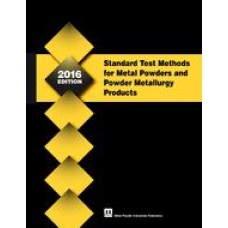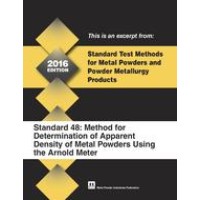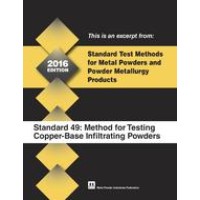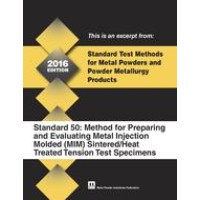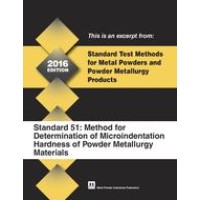Standard Test Methods for Metal Powders and Powder Metallurgy Products, 2016 Edition
- standard by Metal Powder Industries Federation, 2016
- Category: MPIF
$90.00
$45.00
The MPIF Standard Test Methods publication contains 42 standards covering terminology and recommended methods of test for metal powders, powder metallurgy and injection molded parts, metallic filters, and powder metallurgy equipment. These standards, intended to present and clarify PM technology as an aid in conducting business, relate to those activities that concern designers, manufacturers, and users of PM parts.
The 2016 edition contains revisions to 27 standards, including major rewrites of Standards 10 (PM Tensile Properties) and 32 (Estimating Particle Size Using Air Permeability) and includes new Precision Statements for 5 standards.
A new, General Information VI section has been added to this edition that provides details (QR codes and Internet links) on viewing educational video clip demonstrations of the working mechanics of a number of cited test methods.
Includes:
The 2016 edition contains revisions to 27 standards, including major rewrites of Standards 10 (PM Tensile Properties) and 32 (Estimating Particle Size Using Air Permeability) and includes new Precision Statements for 5 standards.
A new, General Information VI section has been added to this edition that provides details (QR codes and Internet links) on viewing educational video clip demonstrations of the working mechanics of a number of cited test methods.
Includes:
- Standard 01 (Sampling Metal Powders) This standard describes two methods for obtaining samples of metal powders for subsequent testing.
- Standard 02 (Determination of Loss of Mass in a Reducing Atmosphere for Metal Powders (Hydrogen Loss)) This standard describes a method for determining the loss of mass of metal powders after heating for a specified time in a reducing atmosphere. This value is commonly referred to as hydrogen loss and approximates the oxygen content of the powder.
- Standard 03 (Determination of Flow Rate of Free-Flowing Metal Powders Using the Hall Apparatus) This standard describes two methods for determining the rate of flow of metal powders. The methods are only suitable for those powders that will flow unaided through the specified Hall flowmeter funnel.
- Standard 04 (Determination of Apparent Density of Free-Flowing Metal Powders Using the Hall Apparatus ) This standard describes a procedure for determining the apparent density of free-flowing metal powders and is suitable for only those powders that will flow unaided through the specified Hall flowmeter funnel.
- Standard 05 (Determination of Sieve Analysis of Metal Powders) This standard describes a method for determining the dry sieve analysis of granular metal powders.
- Standard 06 (Determination of Acid Insoluble Matter in Iron and Copper Powders) This standard describes an analytical method for determination of the acid insolubles content of elemental iron and copper metal powders.
- Standard 09 (Standard Terminology of Powder Metallurgy) This terminology standard includes definitions that are helpful in the interpretation and application of powder metallurgy terms.
- Standard 10 (Determination of the Tensile Properties of Powder Metallurgy (PM) Materials) This standard describes a method for determining the tensile properties of powder metallurgy materials.
- Standard 15 (Determination of Green Strength of Compacted Powder Metallurgy Materials) This method covers the apparatus, test specimens and procedure for determining the green strength of compacted powder metallurgy specimens by subjecting them to a uniformly increasing transverse loading under controlled conditions. The green strength, as used in this standard, is the stress, calculated from the flexure formula, required to break the powder metallurgy compact as a simple beam. The specimen is supported near the ends, and broken by applying the force midway between the fixed center of the supports.
- Standard 28 (Determination of Apparent Density of Non-Free-Flowing Metal Powders Using the Carney Apparatus) This standard describes a procedure for determining the apparent density of non-free-flowing metal powders. It is designed for those powders that do not flow freely through the Hall flowmeter funnel.
- Standard 31 (Terms for Metal Powder Compacting Presses and Tooling ) This standard defines and illustrates schematically (Figs. 1a and 1b) those segments of a metal powder compacting press and the tooling used therein which are directly involved in forming a powder metallurgy compact. Its purpose is to provide the manufacturer and user of such equipment with a uniform and universally acceptable glossary of terms.
- Standard 32 (Estimating Average Particle Size of Metal Powders Using Air Permeability) This standard describes methods for determining the average particle size of a sample of fine metal powders using air permeability of a packed powder bed. This method is not generally used for mixed powders. The values obtained may not be absolute, but are reproducible, and are highly useful on a relative basis for control purposes.
- Standard 39 ( Determination of Properties of Sintered Bronze PM Filter Powders) This standard describes recommended test methods for evaluating the sintered properties of bronze filter powders. It includes methods for the determination of dimensional change, air permeability, maximum pore diameter and strength of standard flat sintered porous metallic bronze filter specimens.
- Standard 40 (Determination of Impact Energy of Unnotched Powder Metallurgy (PM) Test Specimens) This standard covers the apparatus, test specimens, and procedures for the impact testing of PM materials.
- Standard 41 (Determination of Transverse Rupture Strength of Powder Metallurgy (PM) Materials) This standard covers the apparatus, test specimen and procedures for determining the bending strength or transverse rupture strength of powder metallurgy materials.
- Standard 42 (Determination of Density of Compacted or Sintered Powder Metallurgy (PM) Products) This standard describes a method using Archimedes? principle for measuring the density of powder metallurgy products having surface-connected porosity. It is applicable to green, sintered and oil-impregnated specimens. The density of PM products is expressed in grams per cubic centimeter.
- Standard 43 (Determination of the Apparent Hardness of Powder Metallurgy Products ) This standard discusses various testing procedures for determining the apparent hardness (macroindentation hardness) of powder metallurgy products at all stages of manufacturing, from green compact to fully hardened condition. It does not include testing procedures for PF (forged) products or cemented carbides or sintered friction materials.
- Standard 44 (Determination of Dimensional Change from Die Size of Sintered Powder Metallurgy Specimens ) This standard describes a method for determining the change in dimensions of a powder metallurgy specimen after sintering. The dimensional change is the difference, typically expressed as a percentage, between a dimension of the sintered specimen and the corresponding die dimension.
- Standard 45 (Determination of Compressibility of Metal Powders ) This standard describes a test that determines the compressibility of metal powders by measuring the green density of a test specimen resulting from subjecting metal powder to a uniaxial compressive loading in a confining die.
- Standard 46 (Determination of Tap Density of Metal Powders ) This standard describes a test method for measuring the maximum density reached by a metal powder when vibrated under specified conditions.
- Standard 48 (Determination of Apparent Density of Metal Powders Using the Arnold Meter ) This standard describes a procedure for determining the apparent density of both free and non-free flowing powders and premixes. The value obtained may not be the same as that obtained by other apparent density tests but is indicative of the fill characteristics of the powder or premix. See MPIF Standards 04 and 28 for other apparent density test methods.
- Standard 49 (Testing Copper-Base Infiltrating Powders) This standard describes recommended test methods for evaluating the performance of copper-base infiltrating powders. The infiltrant is placed in contact with a part, usually of iron-base composition, and both components are heated to a temperature above the melting point of the infiltrant. Infiltration may be simultaneous with sintering (one-step infiltration) or in a separate step after sintering (two-step infiltration).
- Standard 50 (Preparing and Evaluating Metal Injection Molded (MIM) Sintered/Heat Treated Tension Test Specimens) This standard describes the preparation and evaluation of tension test specimens to be used in determining tensile properties of sintered and heat treated metal injection molded materials.
- Standard 51 (Determination of Microindentation Hardness of Powder Metallurgy Materials) This standard covers the determination of the micro -indentation hardness of PM materials. The procedure differs from that applied to pore-free material in terms of the precautions required to deal with the porosity. This procedure covers tests made with the Knoop or Vickers indentors under test loads in the range from 1 to 200 gf.
- Standard 52 (Determination of Effective Case Depth of Ferrous Powder Metallurgy Products) This standard describes the requirements and inspection methods for measuring the effective case depth of ferrous powder metallurgy products.
- Standard 53 (Measuring the Volume of the Apparent Density Cup Used with the Hall and Carney Apparatus (Standards 04 and 28)) This standard describes a method for measuring the internal volume of the apparent density cup used in MPIF Standards 04 and 28.
- Standard 54 (Determination of Density of Impermeable Powder Metallurgy (PM) Materials) This standard describes a procedure for determining the density of powder metallurgy (PM) materials, including cemented carbides which generally contain less than two percent porosity. The method is based on the principle of water displacement.
- Standard 55 (Determination of Radial Crush Strength (K) of Powder Metallurgy (PM) Materials ) This standard covers the apparatus, test specimens and procedures for the radial crush testing of PM materials. This is a destructive test using a hollow, cylindrical specimen.
- Standard 56 (Determination of Rotating Beam Fatigue Endurance Limit of Powder Metallurgy (PM) Materials) This method applies to ferrous materials which have an endurance limit. The endurance limit is that stress below which the material will not fail in 107 cycles.
- Standard 57 (Determination of Oil Content, Surface- Connected Porosity and Oil-Impregnation Efficiency of Sintered Powder Metallurgy (PM) Products) This standard describes a method for measuring the oil content, surface-connected porosity and oil -impregnation efficiency of powder metallurgy products having surface-connected porosity.
- Standard 58 (Determination of Surface Finish of Powder Metallurgy (PM) Products ) This standard describes a method for measuring the surface finish of powder metallurgy products at all stages of manufacturing, from green compact to fully hardened.
- Standard 59 (Determination of Charpy Impact Energy of Unnotched Metal Injection Molded (MIM) Test Specimens) This standard covers the apparatus, test specimen, and procedure for the impact testing of MIM materials.
- Standard 60 (Preparation of Uniaxially Compacted Powder Metallurgy (PM) Test Specimens ) This standard describes the method and apparatus for the preparation of uniaxially compacted powder metallurgy test specimens.
- Standard 61 (Determination of the Compressive Yield Strength of Powder Metallurgy Materials) This standard describes a method for determining the compressive yield strength of powder metallurgy materials and not the complete compressive stress -strain curve.
- Standard 62 (Determination of the Corrosion Resistance of MIM Grades of Stainless Steel Immersed in 2% Sulfuric Acid Solution ) This standard covers the apparatus, test specimen and procedures for determining the corrosion resistance of MIM (metal injection molded) grades of stainless steel materials immersed in a 2% sulfuric acid (H2SO4) solution. These materials are sintered and may be heat treated or in some other condition typical of MIM processing. This method is not for unsintered material.
- Standard 63 (Density Determination of Metal Injection Molded (MIM) Components (Gas Pycnometer)) This standard covers the apparatus, test specimen and procedures for determining the density of green (asmolded), brown (debound) and sintered MIM components using the gas pycnometer. These components may be heat treated, machined or in some other condition typical of MIM processing.
- Standard 64 (Terms Used in Metal Injection Molding (MIM)) This standard includes definitions of those terms that are necessary for the interpretation and application of metal injection molding and other related standards. The purpose of this standard is to ensure consistency of usage, proper understanding, and precise interpretation.
- Standard 65 (Sample Preparation and Determination of the Hardenability of PM Steels (Jominy End-Quench Hardenability)) This standard describes a method for preparing and determining the hardenability of powder metallurgy steels.
- Standard 66 (Sample Preparation for the Determination of the Total Carbon Content of Powder Metallurgy (PM) Materials (Excluding Cemented Carbides)) This standard describes a method for preparing the specimen used to determine the total carbon content of powder metallurgy materials. This method is NOT applicable to cemented carbides. Types of carbon possibly present in PM materials are also described.
- Standard 67 (Sample Preparation for the Chemical Analysis of the Metallic Elements in PM Materials ) This guide describes the procedures appropriate for the sample preparation of powders, premixes, and PM parts for the chemical analysis of metallic elements excluding iron in ferrous materials.
- Standard 68 (Temperature Profiling a Continuous Mesh-Belt Sintering Furnace ) This guide describes procedures appropriate for checking the thermal profile of a continuous mesh-belt sintering furnace.
- Standard 69 (Determination of the Porosity in Powder Metallurgy Products Using Automated Image Analysis) This guide describes procedures appropriate for measuring the porosity of powder metallurgy products using light optical microscopy and automated image analysis.
Details
- Published:
- 2016
- ISBN(s):
- 9781943694037
- Number of Pages:
- 168
- File Size:
- 1 file , 16 MB
 PDF
PDF
All of our standards document are available in PDF (Portable Document Format), an electronic, downloadable format.You will be able to download the file in your account downloads.
 Multi-User Access
Multi-User Access
After purchasing, you have the ability to assign each license to a specific user.
 Printable
Printable
At any time, you are permitted to make printed copies for your and your members' reference use.

